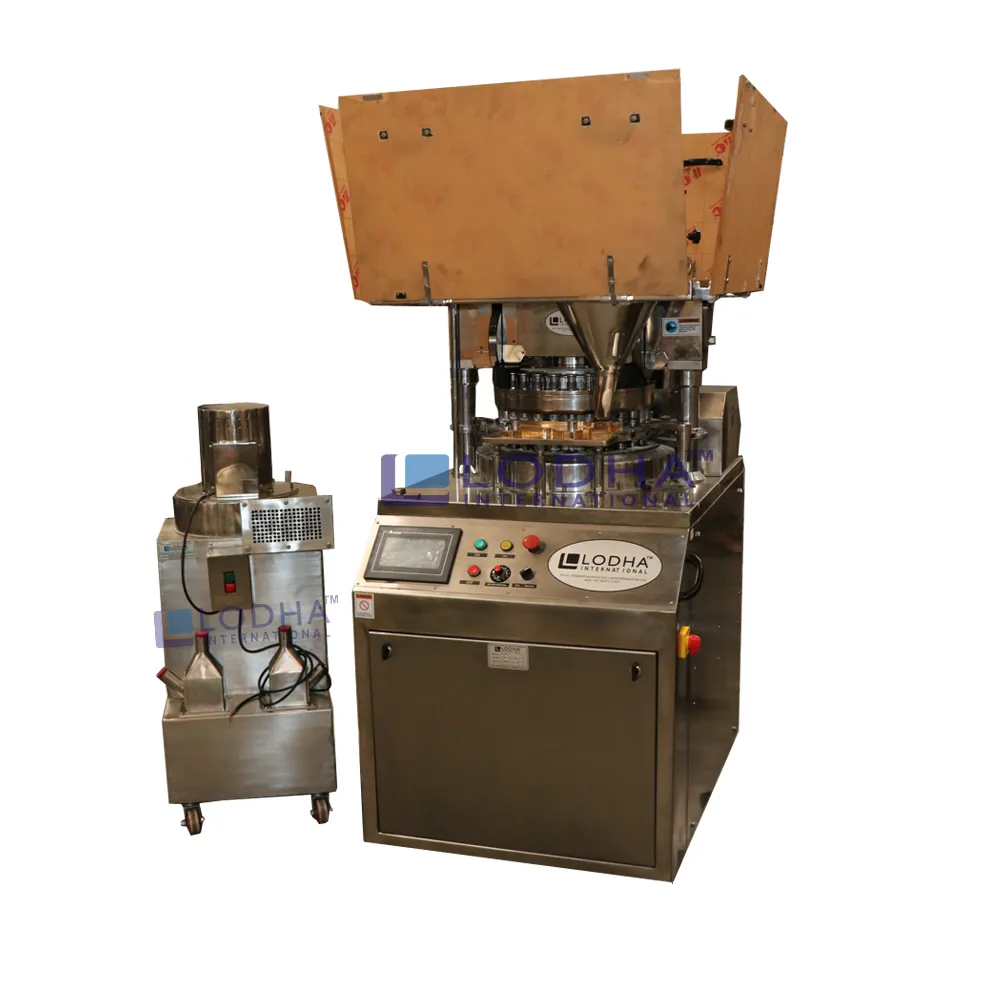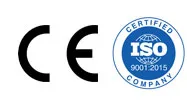Get in touch! +91 9687731331 | +91 9687631331 | info@lodhapharma.com
Double Sided Rotary Tablet Press Machine





Double Sided Rotary Tableting Machine Model: LI-DT is a square type double sided rotary tablet Press equipment promising unmatched quality for medium batch Production. Safety/enhanced performance/cleanability and ease of operation are its most significant features. The suitable model can be selected based on the tooling and output requirement from the 27, 35 & 45 station with “D”, “B” & “BB” tooling respectively.
Manufacturer of Double Sided Rotary Tablet Press Machine is a high technology tablet press with a table-top design and most suitable for medium batch productions. This R&D tablet press is fully equipped with pre-pressing and main pressing systems. Though small and compact, it is fully incorporated for superior quality products. It is upscale from the other tablet presses and this is what makes it unique to be used in laboratory testing and research. Its sturdy nature along with its high-grade components designed by skilled engineers makes this lab rotary tablet press demanded in larger markets. Our High-speed rotary tablet press machine is available with variegated specifications and offers less power consumption with ultimate optimization capacity. Our quality range is highly appreciated for its salient attributes and high tensile strength.
Double Sided Rotary Tablet Press Machine
Having high demand for medicines and fast production process, the need for fast and accurate tableting machines is increasing. These machines are available in various specifications. But one important thing to keep in mind is the capacity of the machine. If the capacity is not adequate, it can lead to improper running and inconsistency of the weight.
These machines have a user-friendly design. Moreover, they are easy to clean. A separate electrical panel and control panel are available for easy maintenance. Also, there are anti vibrating mounts for better stability. In addition, there is an optional hydraulic lubrication pump.
The tooling station consists of the die, upper punch, and lower punch. They all work together to compress powder granules into tablets. The position of these components determines the compression force. The compression force can be controlled from outside the tableting zone.
In order to get smooth and uninterrupted running, the machine is equipped with an internal helical gear ring and pinion drive. This enables the upper punch and lower punch to rotate to various positions. This ensures the proper alignment of the die and punch.
The upper and lower pressure rolls are fitted with ball bearings. These bearings are used to maintain the pre-compression and main compression. This enables the accurate adjustment of the lower cam track. The pre-compression roller helps in removing excess air from the die.
The hopper is connected to the feed shoe, which is responsible for holding the powder mixture. The hopper is mechanically filled, or the granules can be manually inserted.
Rotary Table Press History
Rotary tablet press is a machine that compresses powder into tablets. This process helps reduce formulation wastage and increases output. There are several models of rotary tablet presses. They differ in automation level and pressing speed.
The basic model has a panel on the top and bottom that controls the press. There are also models that have a touchscreen HMI system. Some of these machines have the ability to interact with a pharma management system (MES) to help control weight, hardness, and formulation wastage.
The rotary tablet press has a four-sided glass shield that prevents airborne product separation. This is important when colour printing. It also helps to keep the raw material from being adulterated by mechanical oil.
These machines can produce millions of tablets per hour. Some of the higher-capacity models have custom tableting machine tooling systems. These can be purchased separately from the rotary press. The tools can be installed with a manual filling system or automated.
A segmented rotary turret design helps to increase the number of punching stations. The design also facilitates quick part changeover.
A rotary tablet compression machine should have good ventilation and a three-phase five-wire system. The power supply should not exceed 35 degrees Celsius.
Some rotary tablet presses have a vacuum deduster that sucks surplus powder from the die area. This helps to maintain optimal flow angles, ensuring a steady and consistent flow of raw material.
There are two types of rotary tablet presses: single and double-sided. These are the most common. These machines are classified into different categories according to the type of tooling they use.
Rotary Tablet Press Working Principle
Using several pairs of punches on a working turntable, a rotary tablet press compresses granular powder into tablets. It also has a mechanical buffer device, which prevents overload damage.
The main objective of a tablet press is to produce uniform tablet weight and size. It also controls hardness. This machine uses pressure rollers beneath the lower punch to compress the material.
After a hopper is filled with granular material, it is transported to a feed frame. The granular material is then metered into a die cavity. The size of the die cavity determines the tablet's thickness and size.
The feeding system of the tablet press machine ensures that the powder is fed correctly. The feeder system should be made of high quality stainless steel and 316L design. This ensures that the powder mix will not stick to the feeder housing.
The feeder housing is fitted with a take-off blade that deflects the tablet. A suction box is also installed to absorb the dust generated by the rotating machine. The ejection cam then guides the lower punch upwards and ejects the tablet from the die cavity.
A rotary tablet press is a highly advanced mechanical device that can control the compression of the powder filled cavity automatically. It also has a powder suction nozzle to prevent blockage. This allows the machine to reduce the amount of formulation waste.
The rotary tablet press is available in a range of models. These vary in automation level, speed, and capacity.
Salient Features of Double Sided Rotary Tablet Press Machine:
Technical Specification of Double Sided Rotary Tablet Press Machine:
| Model No. | LI-DT 27D | LI-DT 27B | LI-DT 35B | LI-DT 45B |
| Number of Station | 27” | 27” | 35” | 45 |
| Type of Tooling | ‘D’ | ‘B’ | ‘B’ | ‘BB’ |
| Production Output (Per Hour) | 65,000 – 1,30,000 | 65,000 – 1,30,000 | 70,000 – 1,68,000 | 90,000 – 2,25,000 |
| Max. Operating Pressure | 10 Ton | 6.5 Ton | 6.5 Ton | 6.5 Ton |
| Max. Tablet Diameter | 25 mm | 16 mm | 16 mm | 11 mm |
| Max. Depth of Fill | 20 mm | 17 mm | 17 mm | 17 mm |
| Upper Punch Entry Penetration | 1.5 – 8 mm | 1.5 – 8 mm | 1.5 – 8 mm | 1.5 – 8 mm |
| Turret RPM | 40 RPM | 40 RPM | 40 RPM | 40 RPM |
| Electric Motor | 5 HP, 3 Phase, 1440 RPM, 415 V., 50 Hz | |||
| Overall Dimensions | 1800 mm x 1000 mm x 1040 mm | |||
| Net Weight | 1450 Kilograms | |||

